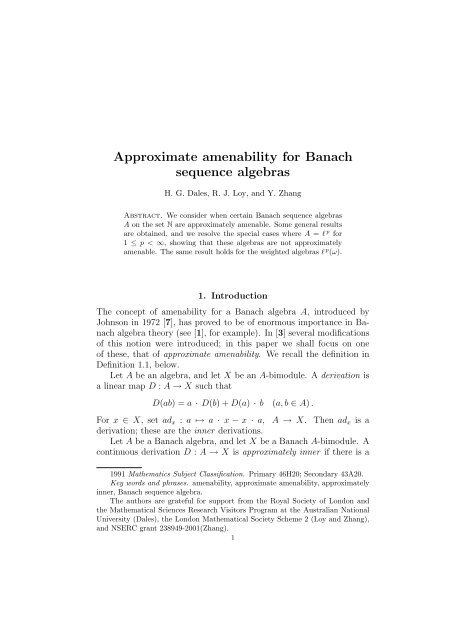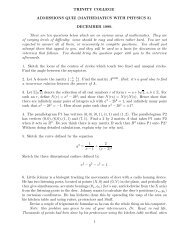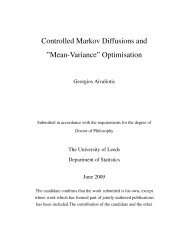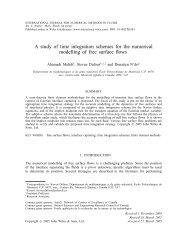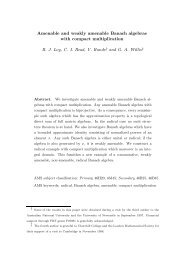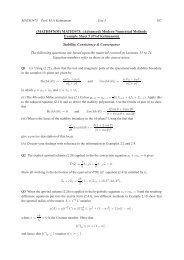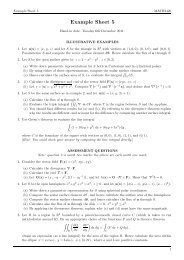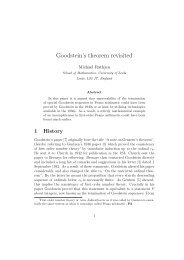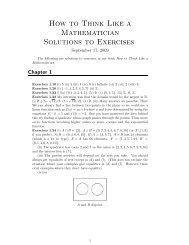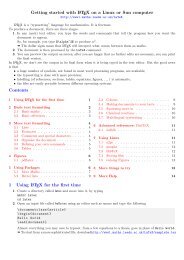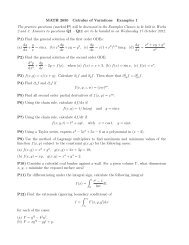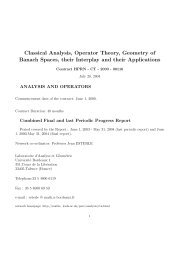Approximate amenability for Banach sequence algebras - CiteSeerX
Approximate amenability for Banach sequence algebras - CiteSeerX
Approximate amenability for Banach sequence algebras - CiteSeerX
Create successful ePaper yourself
Turn your PDF publications into a flip-book with our unique Google optimized e-Paper software.
APPROXIMATE AMENABILITY 32. Basic constructionsWhen determining whether or not our <strong>Banach</strong> <strong>algebras</strong> are approximatelyamenable, we shall work from a characterization of approximatelyamenable <strong>Banach</strong> <strong>algebras</strong> which is a modification of that givenin [3].Let A be <strong>Banach</strong> algebra. The projective tensor product Â⊗A is a<strong>Banach</strong> A-bimodule, under the operations defined byc · a ⊗ b = ca ⊗ b, a ⊗ b · c = a ⊗ bc (a, b, c ∈ A) ,and there is a continuous linear A-bimodule homomorphism π : Â⊗A →A such that π(a ⊗ b) = ab (a, b ∈ A) [1].Proposition 2.1. Let A be a <strong>Banach</strong> algebra. Then A is approximatelyamenable if and only if, <strong>for</strong> each ε > 0 and each finite subsetS of A, there exist F ∈ A ⊗ A and u, v ∈ A such that π(F ) = u + vand, <strong>for</strong> each a ∈ S:(i) ‖a · F − F · a + u ⊗ a − a ⊗ v‖ < ε ;(ii) ‖a − au‖ < ε and ‖a − va‖ < ε .Proof. Suppose that A is approximately amenable. Then by [3,Corollary 2.2] there are nets (M α ) in (Â⊗A) ′′ , and (U α ) and (V α ) in A ′′such that, <strong>for</strong> each a ∈ A:(i) a · M α − M α · a + U α ⊗ a − a ⊗ V α → 0 ;(ii) a − a · U α → 0 and a − V α · a → 0 ;(iii) π ′′ (M α ) − U α − V α → 0 .(This corrects a typographical error in [3].) In each case convergenceis in the ‖ · ‖-topology.Let Y denote the <strong>Banach</strong> space (Â⊗A) ⊕ A ⊕ A ⊕ A. For eacha ∈ A, define a convex set in Y by settingK a := {(a · m − m · a + u ⊗ a − a ⊗ v,a − au, a − va, π(m) − u − v) : m ∈ Â⊗A, u, v ∈ A} .For the specified finite subset S of A,K := ∏ {K a : a ∈ S}is a convex set in the <strong>Banach</strong> space Y S . The conditions above showthat the weak closure of K in Y S contains the zero element 0 of Y S . ByMazur’s theorem, it follows that 0 belongs to the ‖ · ‖-closure of K inY S . Thus, with ε > 0 as specified, there exist F ∈ Â⊗A and u, v ∈ Asuch that clauses (i) and (ii) of the proposition are satisfied and, further,
4 H. G. DALES, R. J. LOY, AND Y. ZHANGsuch that ‖π(F ) − u − v‖ < ε. By modifying F and u slightly, we maysuppose, further, that F ∈ A ⊗ A and that π(F ) = u + v.Conversely, suppose that the condition in the proposition is satisfied.Consider the set D := (0, 1) × F(A), where F(A) is the family offinite subsets of A, and order D by setting(ε 1 , S 1 ) (ε 2 , S 2 ) whenever ε 1 ≥ ε 2 and S 1 ⊆ S 2 .Then (D, ) is a directed set. The conditions show that there existnets (F α ) in Â⊗A, and (u α ), (v α ) in A such that π(F α ) = u α + v α andsuch that, <strong>for</strong> each a ∈ A, we have:a · F α − F α · a + u α ⊗a − a ⊗ v α → 0 ;a − au α → 0 , a − v α a → 0 .Thus we have satisfied the conditions of [3, Corollary 2.2], and so A isapproximately amenable.Corollary 2.2. Let A be a <strong>Banach</strong> algebra with identity e. ThenA is approximately amenable if and only if, <strong>for</strong> each ε > 0 and eachfinite subset S of A, there exists G ∈ A ⊗ A with π(G) = e and suchthat‖a · G − G · a‖ < ε (a ∈ S) .Proof. Suppose that such a G exists, and set u = v = e andF = G + e ⊗ e. Then π(F ) = u + v, and F, u, v satisfy the conditionsof Proposition 2.1.Conversely, suppose that F, u, v satisfy the above condition <strong>for</strong> afinite subset S and with ε/3‖e‖ replacing ε, and setThen π(G) = e, andG = F − u ⊗ e − e ⊗ v + e ⊗ e .‖a·G−G·a‖ ≤ ‖a·F −F ·a+u⊗a−a⊗v‖+‖a−au‖+‖a−va‖ < ε ,and so A is approximately amenable by Proposition 2.1.For comparison, we recall [1], [8] that a <strong>Banach</strong> algebra A is amenableif and only if there is a constant C > 0 such that, <strong>for</strong> each ε > 0and each finite subset S of A, there exists F ∈ A ⊗ A with ‖F ‖ ≤ Csuch that, <strong>for</strong> each a ∈ S, we have:(i) ‖a · F − F · a‖ < ε ;(ii) ‖a − aπ(F )‖ < ε .We remark that (ii) of Proposition 2.1 is exactly the condition thatA has both left and right approximate units [1, Definition 2.9.10]. We
APPROXIMATE AMENABILITY 7We shall later consider only <strong>Banach</strong> <strong>sequence</strong> <strong>algebras</strong> A which areself-adjoint. In such a situation the map a ↦→ a is necessarily continuouson A. It follows that we may replace F by F + F , and so take F to bereal-valued. Similarly, we may also suppose that the elements of the‘test sets’ S are real-valued.Proposition 3.4. Let A be a <strong>Banach</strong> <strong>sequence</strong> algebra. Supposethat there is η > 0 such that, <strong>for</strong> each ε > 0 and each finite subset Sof A, there exists u ∈ c 00 with‖u‖ ≥ η and ‖a − au‖ · ‖u‖ < ε . (3.1)Then A is approximately amenable.Proof. Take u as given by (3.1), with ε replaced by εη/2. SetF = u ⊗ u + ∑ i (u i − u 2 i )δ i ⊗ δ i .Then π(F ) = u and, <strong>for</strong> each a ∈ S, we have‖a · F − F · a − a ⊗ u + u ⊗ a‖ = ‖au ⊗ u − a ⊗ u + u ⊗ a − u ⊗ au‖ < εand ‖a − au‖ < ε. By Proposition 3.3, A is approximately amenable.The converse is immediate.More general <strong>for</strong>ms of this result <strong>for</strong> <strong>Banach</strong> function <strong>algebras</strong> ondiscrete spaces can be shown by the same sort of argument; see, <strong>for</strong>example, [5, Proposition 3.16].We make the conjecture that the sufficient condition in Proposition3.4 is in fact also necessary <strong>for</strong> A to be approximately amenable.Indeed, we do not know an example of a <strong>Banach</strong> <strong>sequence</strong> algebrawhich is approximately amenable, but which does not have a boundedapproximate identity. It is also conceivable that each <strong>Banach</strong> <strong>sequence</strong>algebra A such that c 00 is dense in A and A = A 2 is approximatelyamenable.Corollary 3.5. Let A be a <strong>Banach</strong> <strong>sequence</strong> algebra such thatA has a bounded approximate identity contained in c 00 . Then A issequentially approximately amenable.Proof. It is standard that A has a sequential bounded approximateidentity, say (u n ), in c 00 [1, Corollary 2.9.18], and satisfyinginf n ‖u n ‖ ≥ 1. Let {x n : n ∈ N} be a countable dense subset of A.Then, <strong>for</strong> each n ∈ N, there exists i = i(n) such that ‖x j − x j u i(n) ‖
8 H. G. DALES, R. J. LOY, AND Y. ZHANGThen, <strong>for</strong> each a ∈ A and ε > 0, we have‖a · F n − F n · a − a ⊗ u i(n) + u i(n) ⊗ a‖ = 2‖au i(n) − a‖ · ‖u i(n) ‖ < ε<strong>for</strong> n sufficiently large. Thus (F n , u i(n) ) gives a <strong>sequence</strong> with the requiredproperties of [3, Corollary 2.2]. The sequential variant of [3,Theorem 2.1] holds (with the same argument), and so A is sequentiallyapproximately amenable.Special cases of the above corollary have been shown in [4], whereit is also shown that the converse holds <strong>for</strong> certain <strong>Banach</strong> <strong>sequence</strong><strong>algebras</strong>.We wish to stress that the function F specified in Proposition 3.3must satisfy conditions (i) and (ii) <strong>for</strong> each finite collection S of elements.The following shows that, <strong>for</strong> many <strong>Banach</strong> <strong>sequence</strong> <strong>algebras</strong>A, we can find F to satisfy these conditions <strong>for</strong> each single elementa ∈ A. Indeed the <strong>Banach</strong> <strong>sequence</strong> algebra l 1 satisfies the conditionsof Proposition 3.6 below, but we shall see that it is not approximatelyamenable. To determine whether or not such an algebra A is approximatelyamenable, we must look at sets S with at least 2 elements.We introduce the following notation. Let A be a <strong>Banach</strong> <strong>sequence</strong>algebra on N. For each a ∈ A and each finite or cofinite subset T of N,setP T : a ↦→ ∑ i {a iδ i : i ∈ T } , A → A .We also write P n = P {1,...,n} and Q n = I − P n <strong>for</strong> n ∈ N. The family Cof cofinite subsets of N will be directed by reverse set inclusion.Proposition 3.6. Let A be a <strong>Banach</strong> <strong>sequence</strong> algebra, and leta ∈ A. Suppose thatlim{‖P C a‖ : C ∈ C} = 0 . (3.2)Then, <strong>for</strong> each ε > 0, there exists F ∈ c 00 ⊗ c 00 such that‖∆ a (F )‖ < ε and ‖a − aπ(F )‖ < ε . (3.3)Proof. Let {B i : i ∈ Z + } be the partition of N such that a takesthe constant value a i on B i <strong>for</strong> i ∈ N, such that a takes the value 0 onB 0 , and such that a i ≠ a j whenever i, j ∈ Z + and i ≠ j. Note that, by(3.2), each B i <strong>for</strong> i ∈ N is finite. For n ∈ N, setn⋃∞⋃D n = B i and E n = B i ,i=1i=n+1and set µ(n) = min E n , so that µ(n) → ∞ as n → ∞.Fix ε > 0, and take n 0 ∈ N such that ‖P C a‖ < ε <strong>for</strong> each cofinitesubset C of N with min C > n 0 . Next choose n 1 ∈ N such that n 1 > n 0
APPROXIMATE AMENABILITY 9and µ(n 1 ) > n 0 . Set C = E n1 ∪ (B 0 ∩ [n 1 , ∞)), so that D n1 is finite andC is cofinite with min C > n 0 . Take u to be the characteristic functionof D n1 , so thata − au = aχ N\Dn1 = P C a ,and hence‖a − au‖ = ‖P C a‖ < ε .By (3.2), we may choose m 0 ∈ N with m 0 > n 1 and such thatNow define F as follows.(a) For j, k ≤ n 1 , set|D n1 | · ‖Q m0 a‖ < ε/2 . (3.4)F = 1 on B j × B k ;(b) <strong>for</strong> j ≤ n 1 and n 1 < k ≤ m 0 , setF =−a kon B j × B k ;a j − a k(c) by symmetry <strong>for</strong> k ≤ n 1 and n 1 < j ≤ m 0 ; and(d) at remaining points, F = 0.Note that u ∈ c 00 , F ∈ c 00 ⊗ c 00 , and π(F ) = u. Set ∆ a = ∆ a (F ).Clearly ∆ a is zero except on the sets (B j × B k ) ∪ (B k × B j ) wherej ≤ n 1 and k > m 0 . On the set( ) ( )⋃ ⋃B j × B k ,j≤n 0 k>m 0we see that a · F − F · a and a ⊗ u are zero, and that u ⊗ a = u ⊗ Q m0 a.A similar <strong>for</strong>mula holds when j and k are interchanged. Note thatQ m0 a ⊗ u and u ⊗ Q m0 a have disjoint supports in N × N. Thus∥‖∆ a ‖ = 2‖Q m0 a ⊗ u‖ = 2 ∥∑{Qm0 a ⊗ δ r : r ∈ D n1 } ∥≤2|D n1 | · ‖Q m0 a‖ < εby (3.4). This establishes (3.3).Note the explicit dependence of F on the element a in clause (b),above. One is tempted to try the ‘more obvious’ definition{1 (i, j ≤ n) ,F i,j =0 (otherwise) ,<strong>for</strong> suitably large n ∈ N, so that π(F ) = e n . In this case, F is independentof a. Suppose that S is a finite subset of c 00 (rather than A). Thenour function F satisfies (i) and (ii) of Proposition 3.3 <strong>for</strong> each a ∈ S
10 H. G. DALES, R. J. LOY, AND Y. ZHANG(<strong>for</strong> sufficiently large n ∈ N). However this choice of F does not work<strong>for</strong> all a ∈ A. For example, take A = l 1 , and set a = ∑ j j−3/2 δ j ∈ A.Then∞∑∞∑‖∆ a ‖ = j −3/2 ‖δ j ⊗ e n − e n ⊗ δ j ‖ = 2n j −3/2 ≥ 4j=n+1j=n+1<strong>for</strong> each n ∈ N.In fact, let A = l 1 , and let S be a finite subset of A 2 . Then weclaim that <strong>for</strong> each ε > 0, there exists F ∈ A ⊗ A such that (3.3) holds<strong>for</strong> each a ∈ S. This may add some credence to our conjecture thatA 2 = A <strong>for</strong> an approximately amenable <strong>Banach</strong> <strong>sequence</strong> algebra.To prove this claim, we first recall Pringsheim’s theorem: <strong>for</strong> amonotonic decreasing <strong>sequence</strong> (a i ) ∈ A, one has lim i ia i = 0.Now take a = (a i ) ∈ A with 0 ≤ a i ≤ 1 (i ∈ N). Certainly a i → 0,and so there is a permutation σ of N such that a σ(j) ≤ a σ(i) <strong>for</strong> j ≥ iin N. Thus ia σ(i) → 0. Fix ε ∈ (0, 1), and take n ∈ N such thatja σ(j) < ε/2 <strong>for</strong> j ≥ n and also ∑ ∞j=n+1 a j < ε. Set B = σ −1 (N n ) ∪ N n ,where N n = {1, . . . , n}. Then set u = χ B , the characteristic functionof B, andWe see thatThusF i,j =s := |B| ∑ {a 2 i : i ∈ N \ B} ≤ 2n{1 (i, j ∈ B) ,0 (otherwise) .∞∑j=n+1a 2 σ(j) ≤ nε22∞∑j=n+1j −2 < ε .‖a 2 · F − F · a 2 + u ⊗ a 2 − a 2 ⊗ u‖ = 2‖Q B a 2 ‖ ‖u‖ = s < ε ,and we have built in the fact that ‖a 2 − ua 2 ‖ < ε. It follows that theconditions of (3.3) are satisfied <strong>for</strong> a 2 .For finitely many elements in A 2 , it suffices to consider the casewhere each of them is real-valued, and hence we need only consider differencesof finitely many squares of non-negative elements of A, say theelements are a (1) , . . . , a (k) . We then have finitely many permutationsσ 1 , . . . , σ k of N that respectively render each of these latter <strong>sequence</strong>sdecreasing. We argue as above, with n ∈ N chosen so that, <strong>for</strong> each1 ≤ i ≤ k, we have ja (i)σ i (j) < ε/2k <strong>for</strong> j ≥ n and also ∑ ∞j=n+1 a(i) j < ε.Finally, we setB = N n ∪k⋃i=1σ −1i (N n ) .
The above claim now follows.APPROXIMATE AMENABILITY 114. <strong>Approximate</strong> <strong>amenability</strong> <strong>for</strong> l pTake 1 ≤ p < ∞. Then l p is a <strong>Banach</strong> <strong>sequence</strong> algebra, and c 00 isdense in l p . These <strong>algebras</strong> are discussed in [1, Example 4.1.42].It is well known that l p is weakly amenable, but not amenable.Clearly the <strong>sequence</strong> (e n ) is an approximate identity <strong>for</strong> l p such that‖e n ‖ p = n 1/p (n ∈ N). Certainly each a ∈ l p satisfies equation (3.2)above.It is shown in [3, Example 6.3] that l p is not sequentially approximatelyamenable. In this section we show that l p is not approximatelyamenable.To this end, some preliminaries and further notations are needed.First, note that the mapT : l p × l p → l p (N × N) : T (x, y)(i, j) = x i y j ,is bilinear with ‖T ‖ = 1, and so there is a map˜T : l p ̂⊗ l p → l p (N × N)with ˜T (x ⊗ y) = T (x, y) (x, y ∈ l p ) and ‖ ˜T ‖ = 1. Let H ∈ c 00 ⊗ c 00 .Then∑|H(i, j)| p ≤ ‖H‖ p , (4.1)i,jwhere ‖H‖ denotes the norm of H in l p ̂⊗ l p . (Of course, equalityholds in the case where p = 1.)1Fix throughout γ j =j(j + 1) and set γ = (γ j). Note that γ ispositive, decreasing, and satisfies∞∑kγ k ≤ γ j . (4.2)j=k+1Now let η = (η j ) ∈ l 1 be positive and decreasing, and define elementsa, b in l p by∞∑∞∑a = η 1/pj δ 2j−1 , b = η 1/pj δ 2j .j=1We show that, <strong>for</strong> a suitable choice of η and <strong>for</strong> a certain ε > 0, thereis no element F ∈ c 00 ⊗ c 00 such that both the following inequalitiesare true:‖∆ a (F )‖ + ‖∆ b (F )‖ < ε ; (4.3)‖a − π(F )a‖ + ‖b − π(F )b‖ < ε . (4.4)j=1
12 H. G. DALES, R. J. LOY, AND Y. ZHANGIt would then follow from Proposition 3.3 that l p is not approximatelyamenable.Throughout, we set u = π(F ). As we remarked earlier, we maysuppose that F (and u) are real-valued.We first make a small reduction. We may suppose that ε < η 1/p1 .Now assume that F satisfies (4.4), with ε replaced by ε/2. Thenη 1/p1 (1 − u 1 ) < η 1/p1 /2, and so u 1 > 1/2. By replacing u and F byu/u 1 and F/u 1 , respectively, we find new elements F ∈ c 00 ⊗ c 00 andu ∈ c 00 such that π(F ) = u andu 1 = 1 and ‖∆ a (F )‖ + ‖∆ b (F )‖ < ε .Thus we may always suppose that u 1 = 1.We shall need to estimate ‖∆ x ‖ = ‖∆ x (F )‖ <strong>for</strong> x = a, b, and <strong>for</strong>this we shall use (4.1). Thus we require lower bounds <strong>for</strong> |∆ x (m, n)|<strong>for</strong> m, n ∈ N.First consider the points (2i − 1, 2j), where i, j ∈ N. For convenience,define s = F 2i−1,2j . We calculate the values∆ a (2i − 1, 2j) = η 1/pi (s − u 2j ) ,∆ b (2i − 1, 2j) = η 1/pj (u 2i−1 − s) .In the case where i ≤ j, so that η i ≥ η j , geometrical considerationsshow that|s − u 2j | p η i + |u 2i−1 − s| p η j ≥ η j (|u 2i−1 − u 2j |/2) p .In a similar manner, the points (2i, 2j − 1) taken with i ≤ j − 1 andj ≥ 2, so that η i ≥ η j , lead to the estimate|t − u 2j−1 | p η i + |u 2i − t| p η j ≥ η j (|u 2i − u 2j−1 |/2) p ,where t = F 2i,2j−1 .[At the points (2i − 1, 2j − 1) and (2i, 2j), where i, j ∈ N, we have∆ a (2i − 1, 2j − 1) = (η 1/pi − η 1/pj )F 2i−1,2j−1 − η 1/pi u 2j−1 + η 1/pj u 2i−1 ,∆ b (2i, 2j) = (η 1/pi − η 1/pj )F 2i,2j − η 1/pi u 2j + η 1/pj u 2i ,∆ a (2i, 2j) = ∆ b (2i − 1, 2j − 1) = 0 .Since η i ≠ η j <strong>for</strong> i ≠ j, there are choices of the values of F at the points(2i − 1, 2j − 1) and (2i, 2j) giving zero values to both ∆ a and ∆ b at allthese points. We shall not use this fact.]For u = (u i ) ∈ c 00 , setj−1∞∑ j∑∞∑ ∑Φ p (η, u) = |u 2i−1 − u 2j | p + η j |u 2i − u 2j−1 | p . (4.5)j=1η ji=1j=2i=1
APPROXIMATE AMENABILITY 15and so, in particular, the <strong>for</strong>mula η j = γ 1−pα/qj (j ∈ N) defines a <strong>sequence</strong>η ∈ l 1 which is positive and decreasing.Note that(1 + α+ 1 − p ) 1q q α p = p + q = 1pqand that γ j = η 1/pj · γ (1+α)/qj . For each u ∈ c 00 with u 1 = 1 we applyHölder’s inequality to the <strong>sequence</strong> (x r y r ), where (x r ) has generic termη 1/pj |u 2i−1 − u 2j | or η 1/pj |u 2i − u 2j−1 |, and (y r ) has the correspondinggeneric term γ (1+α)/qj . Thus we obtain1 ≤ Φ 1 (γ, u) =≤∞∑j=1γ j( ∞∑j=1j∑|u 2i−1 − u 2j | +i=1j∑i=1γ 1+αj +≤ (2δ) 1/q Φ p (η, u) 1/p .j−1 ∞∑ ∑j=2i=1∞∑j=2γ 1+αjIt follows that θ p (η) ≥ (2δ) −p/q > 0, as required.Thus we have the following result.∑|u 2i − u 2j−1 |γ jj−1i=1) 1/qΦ p (η, u) 1/pTheorem 4.1. The <strong>Banach</strong> <strong>sequence</strong> <strong>algebras</strong> l p (N), 1 ≤ p < ∞,are not approximately amenable.It is immediate that l p (S) is not approximately amenable <strong>for</strong> anyinfinite set S, since there is a continuous epimorphism l p (S) → l p (N).Take 1 ≤ p < ∞. In [3, Corollary 7.1] it was shown that the <strong>Banach</strong><strong>algebras</strong> l p are essentially amenable, that is, any derivation into thedual of a neo-unital bimodule is inner. From Theorem 4.1 we concludethat essential <strong>amenability</strong> does not imply approximate <strong>amenability</strong>. Italso follows by the Plancherel theorem that L 2 (T) fails to be approximatelyamenable, though by [6, Theorem 4.5] it is pseudo-contractible,that is, it admits a central (unbounded) approximate diagonal.We finally consider a weighted variant of the l p <strong>algebras</strong>.Let ω ∈ [1, ∞) N . For p ≥ 1, we considerl p (ω) = {f ∈ C N : f · ω ∈ l p },where f · ω denotes the <strong>sequence</strong> with the ith coordinate (f · ω)(i) =f i ω i (i ∈ N). With the norm‖f‖ p,ω = ‖f · ω‖ p (f ∈ l p (ω)) ,
16 H. G. DALES, R. J. LOY, AND Y. ZHANGl p (ω) is a <strong>Banach</strong> algebra under pointwise operations. As previously,the map T : l p (ω) × l p (ω) → l p (ω ⊗ ω) = l p (ω ⊗ ω, N × N) given byT (x, y)(i, j) = x i y j (x, y ∈ l p (ω), i, j ∈ N)defines a contractive operator ˜T : l p (ω)̂⊗l p (ω) → l p (ω ⊗ ω), whereω ⊗ ω denotes the weight on N × N such that ω ⊗ ω(i, j) = ω i ω j(i, j ∈ N). As <strong>for</strong> the case of l p , we aim to show that <strong>for</strong> some ε > 0and elements a, b ∈ l p (ω), there is no F ∈ c 00 ⊗ c 00 such that both thefollowing inequalities are true:‖∆ a (F )‖ p,ω⊗ω + ‖∆ b (F )‖ p,ω⊗ω < ε ;‖a − π(F )a‖ p,ω + ‖b − π(F )b‖ p,ω < ε .We take γ = (γ i ) and η = (η i ) the same as in the proof of Theorem4.1. Setand definea =η ′ j =η jω p 2j−1, η ′′j = η jω p 2j∞∑(η j) ′ 1/p δ 2j−1 , b =j=1∞∑j=1(j ∈ N) ,(η ′′j ) 1/p δ 2j ,so that a, b ∈ l p (ω). Now <strong>for</strong> F ∈ c 00 ⊗c 00 and u = π(F ), then followingthe same argument as in the proof of Theorem 4.1, we find that2 p (‖∆ a (F )‖ p,ω⊗ω + ‖∆ b (F )‖ p,ω⊗ω ) p ≥ Φ p (η, u) ,where Φ p (η, u) is given by Equation (4.5). This finally shows that thevalue of ‖∆ a ‖ p,ω⊗ω + ‖∆ b ‖ p,ω⊗ω is bounded away from 0 as a functionof F ∈ c 00 ⊗ c 00 . We there<strong>for</strong>e conclude with the following theorem.Theorem 4.2. The <strong>Banach</strong> <strong>sequence</strong> <strong>algebras</strong> l p (ω), 1 ≤ p < ∞,are not approximately amenable <strong>for</strong> any weight ω.References[1] H. G. Dales, <strong>Banach</strong> <strong>algebras</strong> and automatic continuity, London Math. Soc.Monographs, Volume 24, Clarendon Press, Ox<strong>for</strong>d, 2000.[2] H. G. Dales, A. T.-M. Lau and D. Strauss <strong>Banach</strong> <strong>algebras</strong> on semigroups andtheir compactifications, preprint, 2006.[3] F. Ghahramani and R. J. Loy, Generalized notions of <strong>amenability</strong>, J. FunctionalAnalysis, 208 (2004), 229–260.[4] F. Ghahramani, R. J. Loy and Y. Zhang, Generalized notions of <strong>amenability</strong>,II, in preparation.[5] F. Ghahramani and R. Stokke, <strong>Approximate</strong> and Pseudo-Amenability of A(G),preprint 2005.
APPROXIMATE AMENABILITY 17[6] F. Ghahramani and Y. Zhang, Pseudo-amenable and pseudo-contractible <strong>Banach</strong><strong>algebras</strong>, Math. Proc. Camb. Philos. Soc., to appear.[7] B. E. Johnson, Cohomology in <strong>Banach</strong> <strong>algebras</strong>, Mem. American Math. Soc.#127 (1972).[8] B. E. Johnson, <strong>Approximate</strong> diagonals and cohomology of certain annihilator<strong>Banach</strong> <strong>algebras</strong>, American J. Math., 94 (1972), 685–698.[9] B. E. Johnson, Non-<strong>amenability</strong> of the Fourier algebra of a compact group, J.London Math., 50 (1994), 361–374.[10] A. Yu. Pirkovskii <strong>Approximate</strong> characterizations of projectivity and injectivity<strong>for</strong> <strong>Banach</strong> modules, Math. Proc. Camb. Philos. Soc., to appear.School of Mathematics, University of Leeds, Leeds LS2 9JT, UKE-mail address: garth@maths.leeds.ac.ukMathematical Sciences Institute, Australian National University,ACT 0200, AustraliaE-mail address: rick.loy@maths.anu.edu.auDepartment of Mathematics, University of Manitoba,Winnipeg R3T 2N2, CanadaE-mail address: zhangy@cc.umanitoba.ca


